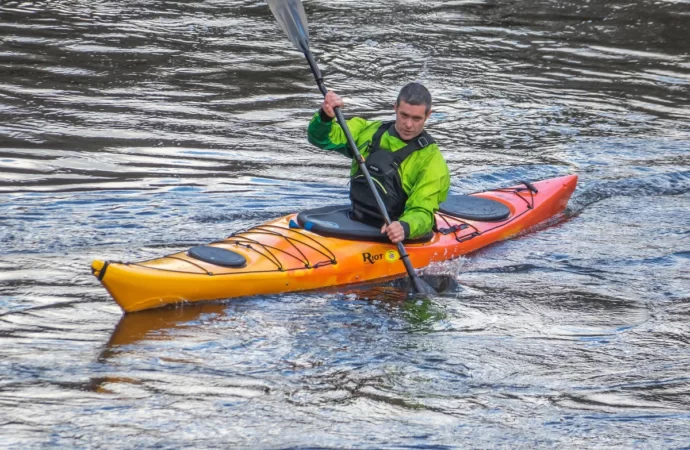Kayaking is a great way to enjoy nature, exercise your body, and challenge your skills. But did you know that kayaking can also benefit from yoga and meditation? Yoga and meditation are practices that can help you improve your flexibility, balance, strength, endurance, focus, and mental health. They can also help you prevent injuries, reduce
Kayaking is a great way to enjoy nature, exercise your body, and challenge your skills. But did you know that kayaking can also benefit from yoga and meditation? Yoga and meditation are practices that can help you improve your flexibility, balance, strength, endurance, focus, and mental health. They can also help you prevent injuries, reduce stress, and enhance your performance and enjoyment on the water.
In this article, we will show you how to incorporate yoga and meditation into your kayaking routine. We will provide some specific examples of yoga poses, meditation techniques, and routines that can help you prepare your body and mind for paddling, relax and recharge during breaks, and recover and celebrate after finishing. Whether you are a beginner or an expert kayaker, you will find some useful tips and tricks to make your kayaking Experience more rewarding and enjoyable.
But before we dive into the details, let’s review some general tips on how to practice yoga and meditation safely and effectively. These tips will help you choose a suitable style, level, and duration for your practice, as well as wear appropriate clothing, use a mat or cushion, and follow a qualified instructor or guide.
General Tips for Kayaking Yoga and Meditation
Yoga and meditation are practices that can be adapted to your personal needs and preferences. There is no one right way to do them, but there are some general guidelines that can help you get the most out of them. Here are some tips to keep in mind when you practice yoga and meditation for kayaking:
There are many different styles of yoga and meditation, each with its own benefits and challenges. For example, some yoga styles are more dynamic and energetic, while others are more gentle and relaxing. Some meditation techniques are more focused and structured, while others are more open and flexible. Depending on your goals and level, you may want to choose a style that matches your needs and abilities. For instance, if you want to improve your flexibility and balance, you may opt for a yoga style that emphasizes stretching and alignment, such as Hatha or Iyengar. If you want to enhance your concentration and awareness, you may opt for a meditation technique that involves paying attention to a specific object or sensation, such as mindfulness or mantra.
Yoga and meditation are practices that can help you grow and improve, but they also require some caution and respect. You should always listen to your body and mind, and avoid pushing yourself beyond your limits. You should choose a level that challenges you but does not strain you, both physically and mentally. For example, if you are new to yoga or meditation, you may want to start with a beginner level, where you can learn the basics and build your confidence. If you are more experienced, you may want to try a more advanced level, where you can deepen your practice and explore new possibilities. However, you should always be mindful of your breath, posture, alignment, and sensations, and stop or modify any pose or technique that causes you pain or discomfort.
Choose a duration that fits your schedule and preference. Yoga and meditation are practices that can be done for any length of time, from a few minutes to a few hours. Depending on your schedule and preference, you may want to choose a duration that fits your lifestyle and goals. For example, if you have a busy schedule or limited time, you may want to do a short session of yoga or meditation before or after paddling, to warm up or cool down your body and mind. If you have more time or desire, you may want to do a longer session of yoga or meditation during a break or at the end of the day, to relax or recharge your body and mind. However, you should always be realistic and flexible about your duration, and adjust it according to your energy level, mood, and conditions.
Wear comfortable clothing that allows movement and breathability. Yoga and meditation are practices that involve moving and breathing in various ways. Therefore, you should wear clothing that allows you to do so comfortably and freely. You should avoid clothing that is too tight or too loose, too hot or too cold, too rough or too slippery. You should opt for clothing that is made of natural or breathable fabrics, such as cotton or wool. You should also consider the weather and the environment where you practice yoga or meditation, and dress accordingly. For example, if you practice yoga or meditation outdoors in the sun or near the water, you may want to wear clothing that protects you from the sun or water exposure, such as sunglasses, hat, sunscreen, or waterproof jacket.
Yoga and meditation are practices that involve sitting or lying on the ground in various positions. Therefore, you should use a mat or cushion that provides support and comfort for your body and mind. You should avoid using a mat or cushion that is too hard or too soft, too thin or too thick, too small or too large. You should opt for a mat or cushion that is made of durable and eco-friendly materials, such as rubber or cork. You should also consider the surface and the space where you practice yoga or meditation, and use a mat or cushion that fits them well. For example, if you practice yoga or meditation on uneven or rough ground, you may want to use a thicker mat or cushion that cushions your joints and bones. If you practice yoga or meditation in a small or crowded space, you may want to use a smaller mat or cushion that does not take up too much room.
Yoga and meditation are practices that involve learning and improving various skills and techniques. Therefore, you should follow a qualified instructor or guide that offers guidance and feedback for your practice. You should avoid following an instructor or guide that is untrained or inexperienced, too fast or too slow, too rigid or too vague. You should opt for an instructor or guide that is certified and knowledgeable, adaptable and responsive, clear and supportive. You should also consider your personality and preference when you choose an instructor or guide, and find one that matches your style and goals. For example, if you prefer a more structured and disciplined approach to yoga or meditation, you may want to follow an instructor or guide that provides detailed instructions and corrections.
Meditation for Mindful Kayaking
Meditation is a practice that involves focusing one’s attention on a single object, thought, or sensation, such as the breath, a mantra, or a sound. Meditation can have many benefits for the mind and body, such as reducing stress, enhancing well-being, improving cognitive functions, and fostering emotional balance.
Kayaking is a water sport that involves paddling a small boat with a double-bladed paddle. Kayaking can be done on various types of water, such as rivers, lakes, seas, or oceans.
Kayaking can also have many benefits for the physical and mental health, such as improving cardiovascular fitness, strengthening muscles, increasing flexibility, and boosting mood.
Meditation and kayaking may seem like two different activities, but they can actually complement each other very well. By meditating during kayaking, one can experience a deeper level of awareness, relaxation, and enjoyment of the natural environment. Here are some reasons why meditating during kayaking can be beneficial:
- Improved focus and mindfulness. Meditation can help one to concentrate on the present moment and avoid distractions. By meditating during kayaking, one can pay more attention to the sensations of the body, the movement of the water, the sound of the paddle, and the sights of the surroundings. This can enhance the performance and safety of kayaking, as well as the appreciation of the beauty of nature.
- Reduced stress and anxiety. Kayaking can be a stressful activity for some people, especially if they are not confident in their skills or face challenging conditions. Meditation can help one to calm down and cope with negative emotions. By meditating during kayaking, one can release tension from the body, breathe deeply and slowly, and cultivate a positive attitude. This can reduce the stress and anxiety associated with kayaking, and make it more enjoyable and relaxing.
- Increased happiness and well-being. Meditation can increase the production of neurotransmitters such as serotonin and dopamine, which are responsible for feelings of happiness and pleasure. Kayaking can also stimulate the release of endorphins, which are natural painkillers and mood enhancers. By meditating during kayaking, one can amplify the effects of these chemicals in the brain, and experience more happiness and well-being.
How to Meditate During Kayaking
There are different ways to meditate during kayaking, depending on one’s preference and experience level. Here are some examples of meditation techniques that can be applied to kayaking:
- This is a simple and effective technique that involves focusing on the breath as it flows in and out of the body. One can synchronize the breath with the strokes of the paddle, inhaling as the paddle enters the water, and exhaling as it exits. One can also count the breaths or repeat a word or phrase with each breath.
- This is a technique that involves scanning the body from head to toe, noticing any sensations, tensions, or emotions that arise in each part. One can start from the top of the head and move down to the face, neck, shoulders, arms, hands, chest, back, abdomen, hips, legs, feet, and toes. One can also relax each part as they scan it.
- This is a technique that involves listening to the sounds around one without judging or reacting to them. One can focus on the sound of the water splashing against the boat or the paddle, the wind blowing through the trees or the hair, the birds singing or chirping in the sky or on land.
- This is a technique that involves imagining a peaceful or pleasant scene in one’s mind’s eye. One can visualize a place that they have been to or want to go to, such as a beach, a forest, a mountain, or an island. One can also imagine themselves being surrounded by light or warmth.
Tips for Meditating During Kayaking
Here are some tips for meditating during kayaking:
- It is advisable to meditate during kayaking when the water is calm and clear, and there are no other boats or people around. This can minimize distractions and interruptions.
- It is important to wear clothing that is appropriate for the weather and water conditions, such as a wetsuit or a drysuit if it is cold or wet. It is also important to wear safety equipment such as a helmet or a life jacket if it is required.
- It is recommended to start with short sessions of meditation during kayaking, such as 5 to 10 minutes at a time. This can help one to get used to the practice and avoid fatigue or boredom.
- It is normal to encounter difficulties or challenges when meditating during kayaking, such as losing focus, getting distracted, feeling restless, or facing obstacles. It is important to be gentle and flexible with oneself, and not to force or criticize oneself. One can simply acknowledge the situation and return to the meditation technique.
Safety on the Water
Yoga and meditation are practices that can enhance the physical and mental health of kayakers. However, they also involve some risks and challenges, especially when done on the water. Therefore, it is important to stay safe while practicing yoga and meditation on the water, and to know what to do in case of emergencies. Here are some tips and precautions for safety on the water:
Check the weather and water conditions. Before going out for kayaking, yoga, or meditation, it is advisable to check the weather forecast and the water conditions, such as the temperature, wind, waves, currents, tides, and visibility. This can help one avoid unfavorable or dangerous situations, such as storms, strong winds, high waves, or low visibility. One can also consult local authorities or experts for advice on the best time and place to kayak, yoga, or meditate.
Wear appropriate clothing and equipment. It is essential to wear clothing and equipment that are suitable for the weather and water conditions, as well as for the activities of kayaking, yoga, or meditation. For example, one should wear a wetsuit or a drysuit if the water is cold or wet, a life jacket or a buoyancy aid if the water is deep or rough, a helmet if there are rocks or obstacles, and sunscreen if the sun is strong. One should also bring a whistle, a flashlight, a compass, a map, a phone, and a first aid kit for emergency purposes.
Practice with caution and moderation. It is important to practice yoga and meditation with caution and moderation on the water, as they can pose some challenges and risks for kayakers. For example, one should avoid poses or techniques that are too difficult or unfamiliar, that require too much balance or flexibility, that restrict breathing or movement, or that cause pain or discomfort. One should also limit the duration and intensity of the practice, and take breaks when needed.
Be aware of the surroundings and other people. It is vital to be aware of the surroundings and other people on the water while practicing yoga and meditation. One should keep a safe distance from other boats or objects, such as rocks, docks, bridges, or buoys. One should also respect the rules and regulations of the waterway, such as speed limits, traffic lanes, or restricted areas. One should also be mindful of the impact of their practice on the environment and wildlife, such as not littering or disturbing animals.
Know how to deal with emergencies. Despite taking precautions and following safety tips, emergencies can still happen on the water while practicing yoga and meditation. Therefore, it is crucial to know how to deal with them effectively and efficiently. For example, one should know how to perform self-rescue or assisted rescue techniques in case of capsizing or falling into the water. One should also know how to signal for help using a whistle, a flashlight, a phone, or a flare. One should also know how to administer first aid for common injuries or illnesses on the water.
Conclusion
Kayaking is a great way to enjoy nature, exercise, and have fun. But it can also be a stressful and challenging activity, especially for beginners or those who face rough waters. That’s why incorporating yoga and meditation into your kayaking routine can be very beneficial for your physical and mental well-being. Yoga can help you improve your flexibility, balance, strength, and endurance, while meditation can help you relax, focus, and cope with any difficulties or fears. In this blog post, we have shared some general tips for kayaking yoga and meditation, as well as some specific techniques for meditating during kayaking. We hope that these tips will help you enhance your kayaking experience and make it more enjoyable and rewarding.
To conclude, kayaking yoga and meditation are two practices that can complement each other and improve your overall health and happiness. By practicing yoga before or after kayaking, you can prepare your body and mind for the activity and recover from any fatigue or soreness. By practicing meditation during kayaking, you can become more mindful of your surroundings, your breath, your emotions, and your actions. You can also use meditation to calm yourself down, overcome any challenges, and appreciate the beauty of nature. However, remember to always follow the safety guidelines on the water and never compromise your attention or awareness. Kayaking yoga and meditation are meant to enhance your kayaking experience, not to distract you from it. So, next time you go kayaking, why not give them a try? You might be surprised by how much they can improve your performance and enjoyment.



















Leave a Comment
Your email address will not be published. Required fields are marked with *